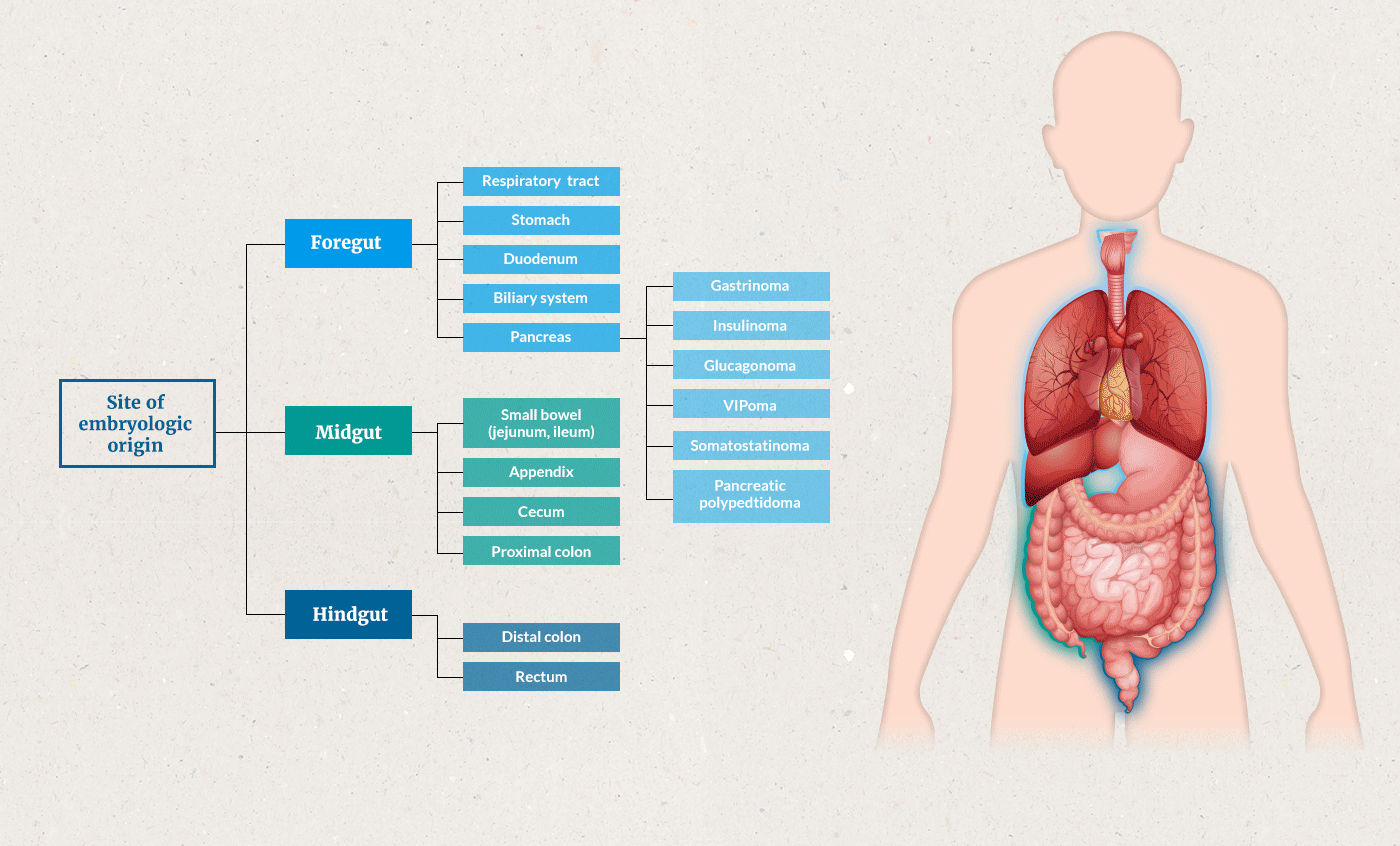The healthcare professional shown in this video speaks about their own opinions and experiences and not about any specific patient. Some treatment options may not be authorized or available in your country. Each person’s case is unique and you should always consult a doctor for information and advice about the diagnosis and treatment of NET. No information within this video constitutes medical advice.
The three main areas where NETs originate from in the body are the gastrointestinal tract (digestive system), the pancreas and the lungs.

Diagram showing where neuroendocrine tumours (NETs) may develop in the body.
Gastrointestinal NETs (GI-NETs) are the most common type of NETs (previously called carcinoid tumours). They are found in the gastrointestinal (GI) tract, including tumours that develop in the small intestine, the appendix, the stomach, the oesophagus, the colon and the rectum.
NETs that occur in the GI tract or pancreas are sometimes grouped together and called gastroenteropancreatic neuroendocrine tumours or GEP NETs for short. The combined number of GEP-NETs cases is now ranked as the second most prevalent gastrointestinal cancer, after colon cancer.
Pancreatic NETs (pNETs) may be classified as functioning tumours or non-functioning tumours:
Functioning pancreatic NETs make extra amounts of hormones, such as gastrin, insulin and glucagon, or other substances known as peptides, such as vasoactive intestinal peptide (VIP), that cause an associated syndrome – or collection of identifiable symptoms in the body.
Non-functioning pancreatic NETs account for the majority of pancreatic NETs. Most non-functioning pancreatic tumours are malignant at diagnosis. They may release certain hormones but these do not cause an associated syndrome. Later on, these tumours may cause abdominal symptoms such as pain due to tumour growth.
There are several subtypes of pancreatic NETs. Each is named according to the type of hormone or substance they produce, as shown in the table below.
| Pancreatic NET types | Main hormone or substance involved | Associated syndrome | Major symptoms |
|---|---|---|---|
| Gastrinomas | Gastrin | Zollinger-Ellison syndrome (ZES) | Ulcers |
| Diarrhoea | |||
| Insulinomas | Insulin | Hypoglycaemia syndrome | Very low blood sugar |
| Weight gain | |||
| Insulin resistance | |||
| VIPomas | Vasoactive intestinal peptide (VIP) | Verner-Morrison syndrome | Watery diarrhoea (pancreatic cholera), which can cause potassium deficiency in the blood or reduced acid secretion in the stomach |
| Glucagonomas | Glucagon | n/a | Rash |
| Glucose intolerance (diabetes) | |||
| Weight loss | |||
| Somatostatinoma | Somatostatin | n/a | High blood sugar (glucose) |
| Diarrhoea (bulky, greasy) | |||
| Reduced acid secretion in the stomach | |||
| Weight loss |
Lung NETs account for around one quarter of all NETs. Within this group there are two major types:
The most frequent symptoms of lung NETs are very common in other conditions, which can make lung NETs very difficult to diagnose.
These symptoms include:
Other rare NETs include those that start in the:
In about 10% of cases it is impossible to determine where the NET has originally started; in this case it is called cancer of unknown primary origin.

Find out how NETs are diagnosed and the tests that healthcare professionals may use to monitor NETs.
Diagnosis & Testing
Read about treatment options for NETs, including surgery, radiotherapy and medications.
Treatment Options